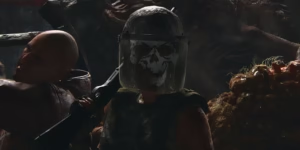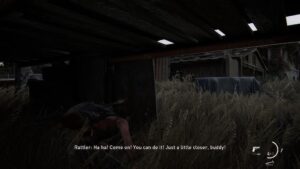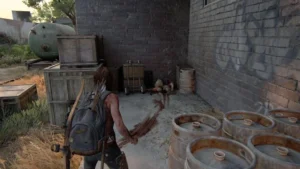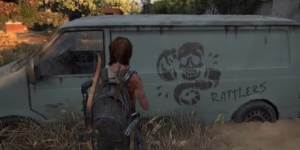
Opening Up New Possibilities: The Rattler Design in The Last of Us Part 2 May Indicate an Adapting Gear System! 2025

Players are still affected by The Last of Us Part 2 long after the credits have rolled. Its graphic story, nuanced characters, and intense gameplay have made a lasting impression. However, the world-building and enemy design exhibit a level of detail that goes beyond the emotional impact. And some astute players have noticed a possible clue—a faint indication that might suggest a more dynamic and changing gear system in later versions of The Last of Us—in the eerie presence of the Rattlers, a distinct faction that appears in the game’s second half.
For those who braved the oppressive heat and desperate encounters of Santa Barbara, the Rattlers are an unforgettable threat. Distinct from the infected and the more organized factions like the WLF and Seraphites, the Rattlers are characterized by their makeshift armor, often adorned with the dried rattles of snakes. This visual distinction isn’t just for aesthetic purposes; it speaks to their resourcefulness, their adaptation to their harsh environment, and their willingness to utilize whatever they can find for protection.
It’s this very element – their visibly scavenged and personalized gear – that has sparked an intriguing theory within the community. Could the Rattlers’ unique appearance be a subtle foreshadowing, a design choice that hints at a more in-depth gear system for players in potential future installments of The Last of Us?
RESIDENT EVIL
Consider this: the crafting system has been essential to survival in both Parts 1 and 2. To make necessary tools, weapons, and medical supplies, players must scrounge for materials. Despite this system’s depth and satisfaction, our protagonists’ visual customization hasn’t changed much. The basic protective gear and functionality are essentially the same, even though we may find different outfits.
The Rattlers, with their clearly modified and individualized armor, present a different picture. They visually embody the idea of adapting and enhancing their defenses based on the resources available. This design choice could be a subtle seed planted by Naughty Dog, suggesting a future where players have more agency in customizing their own protective gear and perhaps even their weaponry beyond the current upgrade system.

Imagine a scenario where, in addition to crafting shivs and medkits, players could scavenge for different types of materials to craft or modify their armor for specific advantages. Perhaps finding reinforced plates could offer better protection against melee attacks, while quieter materials might enhance stealth. The possibilities are vast and could add a significant layer of strategic depth to the gameplay.
The Rattlers’ dependence on scavenged equipment also fits in well with The Last of Us’ post-apocalyptic setting, where survival depends on adaptation and resources are limited. In addition to improving immersion, letting players personalize their equipment both aesthetically and functionally would give them more meaningful options for how to approach various encounters. Do you put more emphasis on direct confrontation by constructing stronger defenses or on stealth by designing lighter, quieter equipment?
A more complex gear system might also make interesting connections with the story. Unique materials and blueprints may be available from various factions or environments, promoting exploration and rewarding players who venture into hazardous areas. While scavenging from infected nests may yield materials with special qualities, perhaps discovering remnants of pre-apocalyptic military equipment could provide better protection.
Naturally, this is just conjecture. The Rattlers’ design might just be an attempt to highlight their dire situation and visually distinguish them. But Naughty Dog is renowned for its painstaking attention to detail and skill at incorporating subliminal clues into its world-building. The potential for a deeper gear system fits in well with The Last of Us’s established mechanics and thematic foundations, and the visual emphasis on the Rattlers’ customized equipment feels purposeful.
It remains to be seen if this theory is eventually realized. However, the strength of Naughty Dog’s design decisions is demonstrated by the fact that the Rattlers’ distinctive style has generated such fascinating conversations within the community. They’ve created a world so rich and detailed that even the appearance of its enemies can fuel speculation about the future of its gameplay mechanics.
Thus, pay more attention to the Rattler’s improvised armor the next time you come across one. In addition to the danger they present right now, you might be seeing a glimpse of a future in which surviving in The Last of Us requires not only what you can make but also what you can actually create for yourself. The possibilities, like the rustling of their namesake, are certainly intriguing.
Gear Up for the Future? Could The Last of Us Part 2’s Rattlers Be the Key to Unlock Enhanced Gameplay Mechanics?

A masterpiece of narrative tension and brutal realism, The Last of Us Part 2 is a game that stays with you long after the heartbreaking conclusion. But beyond the emotional rollercoaster is a world that has been painstakingly created with layers of detail that frequently allude to more profound possibilities. The disturbing existence of the Rattlers, the unique group that is encountered in the sun-baked Rattlers’ desperation of Santa Barbara, is one such fascinating detail. Their distinct, scavenged look, especially their homemade armor with snake rattles, has inspired a strong theory among players: might their design be a subliminal hint at a more advanced and dynamic gear system in later versions of The Last of Us?
Throughout Ellie and Abby’s harrowing journeys in Part 2, the crafting system remains a vital component of survival. Scouring environments for precious resources to create shivs, medkits, and weapon upgrades is a constant necessity. Rattlers While deeply engaging, the visual customization of our protagonists remains largely limited to cosmetic outfits. The core protective gear and its functionality are static, offering little in the way of personalized adaptation.
The Rattlers come on in. They are instantly distinguished by their visual identity. They represent a savage resourceful approach to survival clad in improvised armor that frequently incorporates the very creatures that give them their name. Their equipment isn’t standardized or mass-produced, which is evidence of their adaptability and use of whatever resources the hostile environment has to offer. This visual difference raises the possibility that this is more than merely environmental narrative. Is it a hint of a future in which players will have more control over their own armor and possibly even more precise weapon modifications?

Imagine a future installment of The Last of Us where the crafting system expands beyond its current limitations. Instead of simply finding materials for predetermined recipes, players could scavenge components to craft and Rattlers modify their own armor pieces. Different types of salvaged materials – perhaps reinforced metal plating, lighter fabrics for stealth, or even bio-luminescent elements for navigating dark areas – could offer distinct advantages and disadvantages. This would add a significant layer of strategic depth to gameplay, forcing players to make meaningful choices about how they want to approach Rattlersdifferent encounters and environments.
The Rattlers’ use of customized and scavenged equipment is a perfect fit with The Last of Us’s established themes and world-building. Customizing one’s defenses would improve immersion and feel like a logical extension of the current survival mechanics in a post-apocalyptic world where resources are limited and adaptability is crucial. Do you choose greater agility and stealth with lighter, more flexible materials, or do you prioritize resilience against melee attacks by crafting heavier armor? The choice would be yours, directly impacting your playstyle.
Furthermore, a more robust gear system could weave seamlessly into the narrative. Different regions or factions could yield unique crafting materials and blueprints, incentivizing exploration and rewarding players for venturing into dangerous and unfamiliar territories. Discovering remnants of pre-apocalypse military technology could unlock advanced armor modifications, while scavenging from overgrown settlements might yield materials with unique environmental resistances.

It’s important to keep in mind that this is still just a theory supported by the Rattlers’ fascinating visual style. Their distinct style might just be a means for Naughty Dog to convey their resourcefulness and desperate Rattlers in the story. But it’s impossible to overlook the studio’s reputation for attention to detail and their ability to obliquely hint at upcoming events. A possible seed for future gameplay development is the intentional visual emphasis on the Rattlers’ customized equipment.
The beauty of The Last of Us lies in its ability Rattlers to immerse players in a world that feels both brutal and believable. Introducing a more dynamic gear system, hinted at by the very design of the Rattlers, could further enhance this immersion and provide players with even greater agency in their struggle for survival. Whether this speculation proves accurate remains to be seen, but the very thought of a more personalized and adaptable gear system in the future of The Last of Us is undeniably exciting, opening up a wealth of new gameplay possibilities and further deepening our connection to this unforgettable world. The future of survival might just be in the gear we choose to forge.




